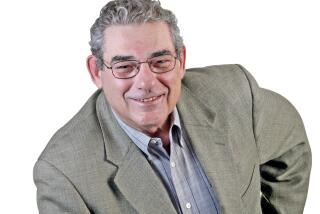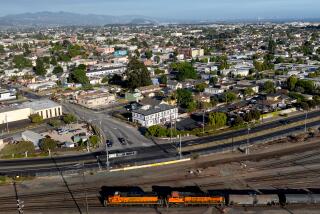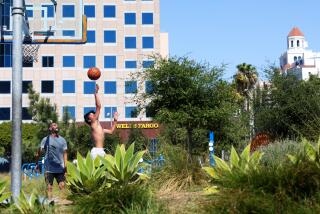Now, that’s hard news
Leon Rudek loved his newspaper job so much that he constructed a sidewalk in front of his house out of front pages.
Pedestrians walking along La Prada Street in Highland Park step back in time as they pass by concrete “editions” of newspapers reporting the news that “Yankees KO Dodgers, Again,” or “Argentina Invades Falklands” and “How Carter Saved Summit.” All in screaming headlines.
And those who take a closer look may notice that dozens of the front pages cover the bottom of the slope behind his house, and hundreds more serve as roofing shingles on the garage-workshop.
“He chose the biggest headlines,” said Rudek’s widow, Marta, of the newspaper sidewalk.
Rudek was a machinist for the Los Angeles Times for 27 years and used the plastic printing plates, part of a process long ago phased out, as molds for the concrete front pages.
At the end of his shift, Rudek would gather some of the more interesting front page plates -- usually from the “Late Final” street edition that used big headlines -- and take them home. There, he put them in homemade molds and poured concrete on top. Once the heavy panels had hardened, he peeled away the plates to reveal readable images of front pages etched in concrete -- 60 of which he used to form the sidewalk.
“I was born in 1966, so these events help set up a chronology of my life,” said John Rudek, one of the former newspaperman’s sons. “There were these events taking place, like the pope being replaced and Nixon resigning.
“These were frames of reference for me.”
Rudek retired from the newspaper in 1991 and died 11 years later at age 75.
Born in Poland, Rudek was 13 when the Nazis invaded his country. One day when he was going to a market to buy bread for his family, German SS officers grabbed him and took him to a farm, where they put him to work.
“They treated him like a slave,” said his son Dr. Robert Rudek, a Riverside surgeon. “He escaped and found his way to England and found a group of Poles who formed a Polish army. He was just a kid, 16, too young to fight. But he went to North Africa and Italy anyway.”
Though the elder Rudek had only a sixth-grade education, after the war he was unwilling to return to Poland and resume his education, said Marta, who now lives in Pasadena. “He was afraid of the Communists.”
When he learned it would take about eight years to immigrate to the U.S., Rudek decided in 1948 to relocate to Argentina, where numerous Poles had fled after the war. That’s where he met his future wife, also a Polish immigrant. They married in 1949 when Rudek was working as a blacksmith and ironworker. He brought his young family to this country in 1962 when architect Richard J. Neutra sponsored their immigration.
Rudek had done some work for Neutra, who responded by writing “a beautiful letter of recommendation” describing his skills and work ethic that Rudek used to land his job at The Times in 1965, Marta said.
His knowledge of how things worked paid off when the newspaper opened its Olympic Boulevard printing plant downtown. The pressroom was equipped with robotic machines to move two-ton rolls of newsprint. But the robots malfunctioned when being directed to turn at certain intersections. The manufacturer sent engineers from New York to fix them, but they couldn’t locate the problem.
Rudek surmised that the electronic chips embedded in the floor that directed the robots were in the wrong place. So he chiseled them out and moved them to a spot where they could signal the robots which way to go. These days, the robotic paper-movers are equipped with lasers that direct them to the proper location.
Another son, Norbert, said the family grew up with representations of The Times everywhere they looked. Not only did the workshop-garage boast a blue plastic-plate roof, but Leon Rudek also built the front gate out of castoff pressroom mop and broom handles.
“He lived and breathed the newspaper. Everything was Otis Chandler this and Otis Chandler that. We were immersed in L.A. Times lore,” said Norbert, a financial advisor who works in Florida.
The front-page sidewalk still attracts attention. Michael Galaviz, who lives nearby and is a Los Angeles history buff, said that each time he walks past 6012 La Prada St. he’s intrigued by headlines like the June 1, 1979, banner “L.A. Cancels Summer School” and the Jan. 24, 1981, headline about the space shuttle landing at Edwards Air Force Base: “What a Way to Come to California.”
The current owners of the home, artists Molly Millar and Michael Dodge, purchased it in April. They plan to preserve Rudek’s handiwork and have invited people, including former Times pressman Ed Padgett, to examine the collection of front pages and the printing plate roof above what they now use as an art studio.
Retired pressman Emmett Jaime III of West Covina said many press operators saved the old-fashioned mats as souvenirs from the even earlier lead-plate letterpress era, even though they contained asbestos.
Longtime neighbors have helped Millar and Dodge piece together Rudek’s past. And the discovery of a homemade pipe “safe” embedded in concrete in the home’s basement has filled in some of the blanks.
When he pried open the safe, Dodge discovered Rudek’s Polish passport, paperwork that listed his birth date as Jan. 2, 1927, his welder’s certificate, old photos, and family members’ Social Security cards and other official papers.
The pair, who are engaged to be married, have carefully preserved the documents and plan to return them to the Rudek family.
--
More to Read
Sign up for Essential California
The most important California stories and recommendations in your inbox every morning.
You may occasionally receive promotional content from the Los Angeles Times.











